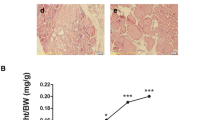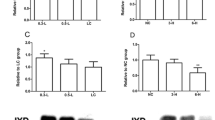Abstract
Objective
Thyroid-stimulating hormone (TSH) binds TSH receptor (TSHR) on thyroid cell membranes, which will lead activation of cyclic adenosine 3′,5′-monophosphate/protein kinase A signaling pathway. Through this pathway, TSHR regulates the expression of sodium–iodide symporter (NIS) to complete iodine intake. In recent studies, it is found that TSHR is widely expressed in a variety of extra-thyroidal tissues. TSHR expressions as well as distribution in normal mammary gland tissues have not been reported. The physiological mechanism of the TSHR in the extra-thyroidal tissues has also been controversial.
Methods
In this study, immunohistochemistry and immunofluorescence were used to characterize the expression distribution of TSHR protein in lactating breast. DNA sequence of TSHR cDNA from mice lactating breast was determined and then compared with TSHR cDNA from mice thyroidal tissue.
Results
A 173 amino acid (AA) fragment deletion was found in the extra-cellular domain of lactating breast TSHR. The expression levels of NIS mRNA were compared between two tissues, and the level of NIS mRNA in lactating breasts was lower than the one in thyroidal tissues.
Conclusion
The lower expression of NIS in lactating breast may be due to the 173 AA deletion in the TSHR resulting the lower binding of TSH to the TSHR. For the first time, this finding may explain the reason of the lower NIS expression in lactating breast.







Similar content being viewed by others
References
Orsolya D, Antonio DL, Viktoriya P, Claudia R, Mona A, Mia R, Christopher S (2003) The sodium/iodide symporter (NIS): characterization, regulation, and medical significance. Endocr Rev 24:48–77
Bosch EH, Doorne HV, Vries SD (2000) The lactoperoxidase system: the influence of iodide and the chemical and antimicrobial stability over the period of about 18 months. Appl Microbiol 89:215–224
David SC, Gerard MD, Bryan RH, Richard TK, Stephani LL, Susan JM (2009) Revised american thyroid association management guidelines for patients with thyroid nodules and differentiated thyroid cancer. Thyr Cancer Guidel 19:1167–1214
Dremier S, Pohl V, Smith CP, Roger PP, Corbin J, Doskeland SO, Dumont JE, Maenhaur C (1997) Activation of cyclic AMP-dependent kinase is required but may not be sufficient to mimic cyclic AMP-dependent DNA synthesis and thyroglobulin expression in dog thyroid cells. Mol Cell Biol 17:6717–6726
Laurberg P, Andersen S, Knudsen N, Ovesen L, Nøhr SB et al (2002) Thiocyanate in food and iodine in milk: from domestic animal feeding to improved understanding of cretinism. Thyroid 12:897–902
Vayre L, Sabourin JC, Caillou B, Ducreux M, Schlumberger M (1999) Immunohistochemical analysis of Na+/I-symporter distribution in human extra-thyroidal tissues. Eur J Endocrinol 141:382–386
Cho JY, Leveille R, Kao R, Rousset B, Parlow AF, Burak WE (2000) Hormonal regulation of radioiodide uptake activity and Na+/I-symporter expression in mammary glands. Clin Endocrinol Metab 85:2936–2943
Tazebay UH, Wapnir IL, Levy O, Dohan O, Zuckier LS, Zhao QH (2000) The mammary gland iodide transporter is expressed during lactation and in breast cancer. Nat Med 6:871–878
Xue Y, Hongmei S, Lixiang L, Lin L, Meili G, Shinan W (2012) Changes of sodium iodide symporter regulated by IGF-I and TGF-β1 in mammary gland cells from lactating mice at different iodine levels. Biol Trace Elem Res 146:73–78
Oh HJ, Chung JK, Kang JH, Kang WJ, Noh DY et al (2005) The relationship between expression of the sodium/iodide symporter gene and the status of hormonal receptors in human breast cancer tissue. Cancer Res Treat 37:247–250
Williams GR (2011) Extrathyroidal expression of TSH receptor. Ann Endocrinol 72:68–73
Silvana B, Renata DC, Giuseppina N, Francesca F, Valter L, Marcella S, Pier AB, Giorgio I (2009) TSH induces co-localization of TSH receptor and Na/K-ATPase in human erythrocytes. Cell Biochem Funct 27:259–263
Satoshi N, Tomonobu H (2015) TSH resistance revisited. Jpn Endocr Soc 4:1–6
Riedel C, Levy O, Carrasco N (2001) Post-transcriptional regulation of the sodium/iodide symporter by thyrotropin. Biol Chem 276:21458–21463
Mariko S, Moyuru H, Akira K, Takeshi A, Kazunari T, Aya Y, Takeshi H, Yuko I, Tetsuhide T, Shin-Ichiro I, Norihisa SK (2012) Thyroglobulin (Tg) activates MAPK pathway to induce thyroid cell growth in the absence of TSH, insulin and serum. Biochem Biophys Res Commun 420:611–615
Carrasco N (1993) Iodide transport in the thyroid gland. Biochim Biophys Acta 1154:65–82
Ajjan RA, Kamaruddin NA, Crisp M, Watson PF, Ludgate M et al (1998) Regulation and tissue distribution of the human sodium iodide symporter gene. Clin Endocrinol (Oxf) 49:517–523
Tonacchera M, Viacava P, Fanelli G, Agretti P, De Marco G et al (2004) The sodium–iodide symporter protein is always present at a low expression and confined to the cell membrane in nonfunctioning nonadenomatous nodules of toxic nodular goiter. Clin Endocrinal (Oxf) 61:40–45
Kogai T, Taki K, Brent GA (2006) Enhancement of sodium/iodide symporter expression in thyroid and breast cancer. Endocr Relat Cancer 13:797–826
Paschke R, Ludgate M (1997) The thyrotropin receptor in thyroid disease. N Engl J Med 337(23):1675–1681
Van Sande J, Parma J, Tonacchera M, Swillens S, Dumont J, Vassart G (1995) Somatic and germline mutation of the TSH receptor gene in thyroid disease. Clin Endocrinol Metab 80(9):2577–2585
Wsdsworth HL, Chazenbalk GK, Nagayama Y, Russo D (1990) Rapopot. An insertion in the human thyrotropin receptor critical for high affinity hormone binding. Science 249:1423–1425
Atassi MZ, Manshouri T, Sakata S (1991) Localization and synthesis of the hormone-binding regions of the human thyrotropin receptor. Proc Natl Acad Sci 88:3613–3617
Acknowledgments
This work was supported by the National Natural Science Foundation of China (81273012) and by the Doctoral Tutor for Doctor’s Degree from the Ministry of Education (20122307110010).
Author information
Authors and Affiliations
Corresponding author
Ethics declarations
Conflict of interest
The authors had no conflict of interest to declare.
Ethnical approval
All applicable international, national, and/or institutional guidelines for care and use of animals were followed. And this project was approved by the Ethical Review Board of Harbin Medical University.
Informed consent
Formal consent is not required.
Rights and permissions
About this article
Cite this article
Shi, XZ., Xue, L., Jin, X. et al. Different expression of sodium–iodide importer (NIS) between lactating breast and thyroid tissues may be due to structural difference of thyroid-stimulating hormone receptor (TSHR). J Endocrinol Invest 40, 41–48 (2017). https://doi.org/10.1007/s40618-016-0524-7
Received:
Accepted:
Published:
Issue Date:
DOI: https://doi.org/10.1007/s40618-016-0524-7




